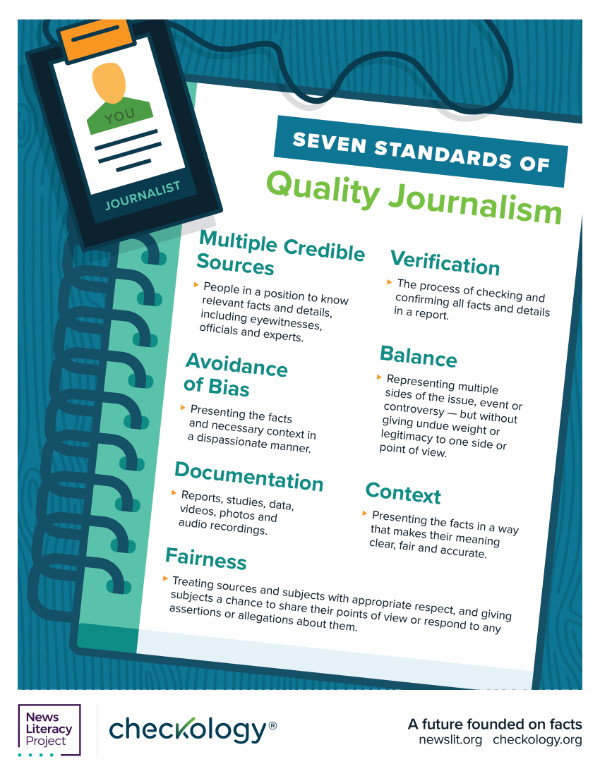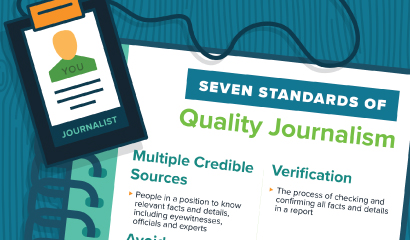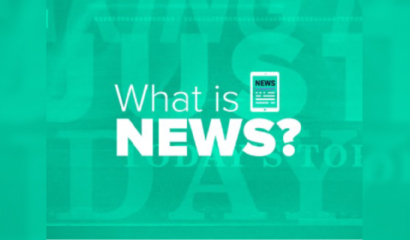Seven standards of quality journalism

The standards and practices of quality journalism are complex, numerous and dynamic, and are implemented differently by different journalists and different news organizations under different circumstances on different pieces of journalism. See a trend here? Practicing journalism is complicated and nuanced. Still, the general purpose behind the standards is the same: to produce the most accurate, fair and useful information possible.
Some journalism standards are obligatory (such as the prohibition against making things up) and quantifiable (such as newsroom policies about the use of anonymous sources), while others are aspirational (such as the attempt to eliminate bias and to be as fair and accurate as possible) and require judgment and discussion to apply (such as assessing newsworthiness, evaluating sources and determining fairness).
 In almost all cases at major news organizations, these standards are subject to constant reconsideration and revision — whether to prevent the recurrence of an error or to adapt to new tools and methods of gathering and reporting information (for example, using social media to locate sources, or livestreaming breaking news events).
In almost all cases at major news organizations, these standards are subject to constant reconsideration and revision — whether to prevent the recurrence of an error or to adapt to new tools and methods of gathering and reporting information (for example, using social media to locate sources, or livestreaming breaking news events).
By introducing students to the major standards of quality journalism, and helping them understand their nature and rationale, you’re providing them with conceptual and analytical tools that they can use to evaluate the credibility of the information they encounter daily and, in some cases, to critically respond to it. This knowledge can also activate a wide variety of high-level news literacy discussions in your classroom and beyond.
The seven primary standards of quality journalism and their descriptions are included in the poster linked below. This poster is adapted from a highly interactive, immersive learning experience in our Checkology® virtual classroom in which students are placed in the role of a rookie reporter on the scene of a breaking news event and learn the standards of quality journalism by “covering” the story. They are guided by their editor and a veteran reporter back in the newsroom throughout the process, and can use their virtual notebooks to see their progress in following the standards. At the end of the lesson, they build the story, selecting the most appropriate headline, lead, image and more. Use this poster with the Checkology lesson “Practicing the Standards of Quality Journalism” or on its own.
News judges
 Newsworthiness is a key news literacy concept. It helps students understand that what appears as “the news” on any given day is the result of a series of judgments and conversations in newsrooms across the country and around the world. Helping students understand the major factors that drive news judgment — how important, interesting, unique and timely an event or issue is — is vital to helping them understand and think critically about the news they encounter in their daily lives. Requiring them to make news judgments of their own can help them appreciate how difficult such decisions can be and learn how to evaluate and respond to the judgment of professional journalists.
Newsworthiness is a key news literacy concept. It helps students understand that what appears as “the news” on any given day is the result of a series of judgments and conversations in newsrooms across the country and around the world. Helping students understand the major factors that drive news judgment — how important, interesting, unique and timely an event or issue is — is vital to helping them understand and think critically about the news they encounter in their daily lives. Requiring them to make news judgments of their own can help them appreciate how difficult such decisions can be and learn how to evaluate and respond to the judgment of professional journalists.
News judgment frequently plays a role in criticism of news media. Politicians, activists and the public often complain about how much — or how little — news coverage is given to a particular issue or event. But sometimes these complaints do not accurately reflect actual reporting. (You should make a point of noting to students that while many people make assertions about what news media do or do not cover, it’s always important to verify whether those assertions are true by surveying and reviewing actual coverage.)
Giving students an understanding of newsworthiness as a concept, and helping them develop the skill of news judgment, allows students to do more than just criticize; it enables them to enter the conversation about so-called agenda-setting and to engage with such criticisms when and where they encounter them.
In this lesson, students use four key criteria to explore how journalists determine which events to cover, and feature as top stories, in a news cycle. Then they apply these criteria to both hypothetical and actual news events to make their own news judgments.
This lesson makes the following essential questions available:
- What makes an issue or event “news,” and who decides?
- What factors should be used to determine which issues and events are newsworthy, and who decides?
- How should news outlets decide which stories to feature? In other words, which stories should lead a television newscast, or be placed on the front page of a newspaper?
- How might the level of diversity in a newsroom influence news judgments?
This news literacy classroom activity is suggested for grades 7-9 and 10-12+.
Key terms:
- News judgment
- Newsworthiness
- News value
- Lead story
Connections with other NLP resources:
- “What Is News?” lesson on NLP’s Checkology® virtual classroom
About classroom lessons:
- NLP’s lesson plans cover core news literacy subjects that help provide educators with the resources to design their own units. Many of these lessons have a corresponding version on NLP’s e-learning platform, Checkology. You can find activities, quizzes, infographics and posters that complement many lessons in NLP’s resource library.